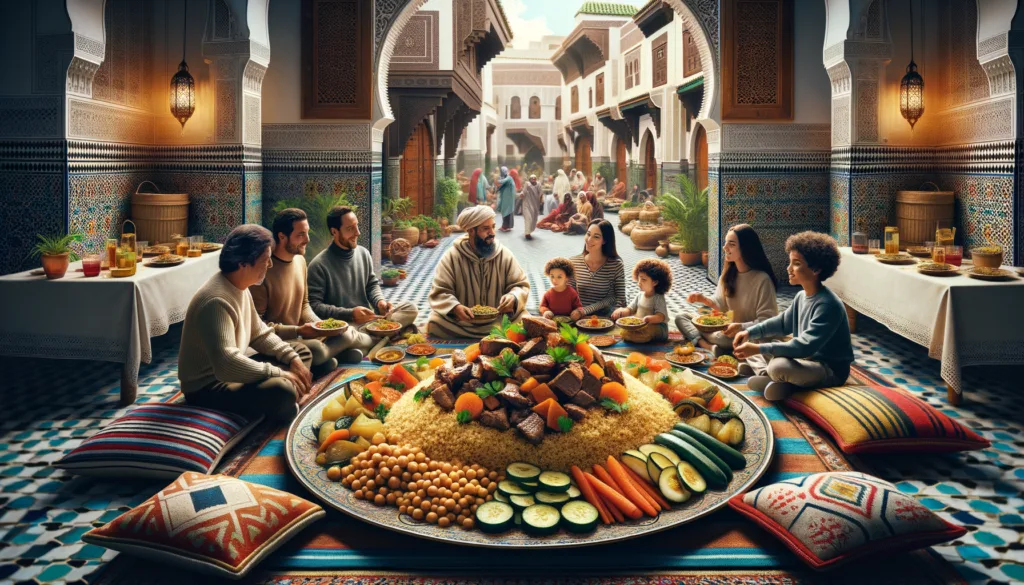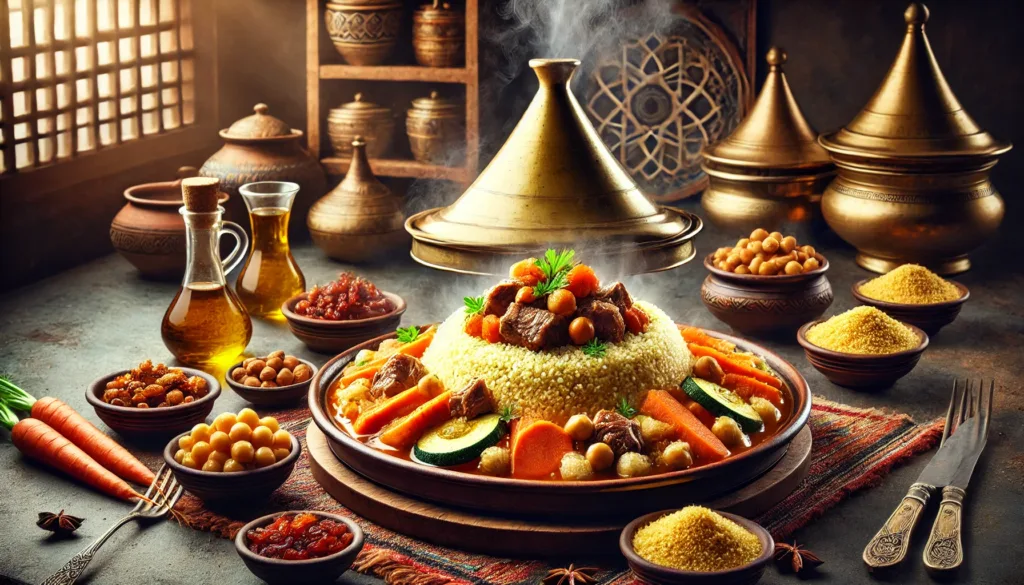
Moroccan cuisine is a vibrant mosaic of flavors, rich traditions, and centuries-old culinary artistry. Among its most celebrated dishes stands one truly iconic staple: couscous. More than just a meal, couscous is a symbol of togetherness, hospitality, and heritage in Moroccan culture.
Deeply embedded in the fabric of daily life, couscous is one of the most eaten and loved dishes in Morocco. It graces tables across the country, uniting families every Friday after the midday prayer and serving as a delicious accompaniment to joyous celebrations. This humble yet exquisite dish has captivated both locals and visitors alike, offering a taste of Morocco’s soulful gastronomy in every bite.
What is Couscous?
A Staple of Moroccan Cuisine
Couscous is a traditional North African dish made from crushed and steamed durum wheat semolina. Though often mistaken for a grain, it is actually a type of tiny pasta, prepared in a unique way that enhances its light, fluffy texture.
Delicate Flavor and Versatility
With a mild, slightly nutty flavor, couscous serves as the perfect base for a variety of Moroccan stews and sauces. It easily absorbs surrounding flavors, transforming depending on the spices, vegetables, and proteins that accompany it. Whether served with slow-cooked meats, hearty vegetables, or sweet caramelized onions and raisins, couscous demonstrates remarkable culinary versatility.
A Dish That Adapts to Every Occasion
From elaborate feasts to simple family meals, couscous takes on countless variations, reflecting Morocco’s diverse regional influences. Whether prepared in a grand couscoussier or in a modern kitchen, this dish continues to bring people together, carrying forward generations of tradition and flavor.
The Cultural Significance of Couscous
A Symbol of Moroccan Heritage
Couscous is more than just a meal in Morocco; it is a symbol of heritage, unity, and tradition. Often referred to as Morocco’s national dish, couscous is deeply embedded in the country’s culinary and cultural fabric. Its preparation and consumption carry strong emotional and social significance, making it an integral part of Moroccan identity.
Friday Traditions and Family Gatherings
In Moroccan households, couscous holds a special place, particularly on Fridays. After the midday prayer, families gather to share a communal couscous meal, reinforcing bonds among relatives and friends. This tradition goes beyond mere sustenance—it is a ritual of togetherness and hospitality.
Serving couscous at gatherings emphasizes Moroccan values of sharing and generosity. Typically, the dish is placed at the center of the table, and family members eat from a single large platter, symbolizing unity. This communal way of dining strengthens family ties and connection to ancestral customs.
Couscous in Celebrations and Religious Occasions
In Morocco, couscous is prepared for special occasions such as weddings, births, and religious festivities. It is a dish that marks moments of joy and togetherness, bringing people together during both celebrations and times of mourning. The act of making couscous is often a collaborative effort, where different family members contribute to the preparation, reinforcing its communal nature.
How Couscous is Prepared and Served

The Traditional Couscoussier Method
Authentic Moroccan couscous is prepared using a special double-tiered steamer called a couscoussier. The bottom pot is used to cook a flavorful broth with meats, vegetables, and seasoned spices, while the top section steams the small, crushed semolina grains.
Steaming the Couscous
Rather than boiling the couscous, it undergoes a meticulous steaming process, which enhances its fluffy texture. The grains are first moistened, fluffed by hand, then placed in the steamer above the simmering broth. This process is repeated multiple times to ensure light, airy grains with optimal absorption of flavors.
Ingredients and Flavor Combinations
Couscous is incredibly versatile and pairs well with an array of ingredients. A classic Morrocan couscous typically includes tender meat (such as lamb, chicken, or beef), vibrant vegetables (carrots, zucchini, turnips, and pumpkin), and a rich blend of spices like cumin, coriander, saffron, and cinnamon.
Vegetable and Spice Infusions
The accompanying broth absorbs the deep flavors of slow-cooked meats and vegetables, creating a fragrant, comforting ensemble. Additional enhancements such as chickpeas, raisins, or caramelized onions add layers of flavor, making each bite dynamic and rich.
Traditional Serving Style
When it’s time to serve, the couscous is arranged in a large communal dish, forming a small pyramid in the center. The meat and vegetables are carefully placed around and on top of the couscous, while the broth is usually served on the side. This method allows guests to pour the desired amount of sauce onto their portion, ensuring a customizable experience.
Regional Variations and Accompaniments
Different regions in Morocco have unique takes on couscous. For example, in Berber traditions, couscous is sometimes paired with buttermilk, providing a creamy contrast to the dish’s rich flavors. Some variations also highlight sweet-savory combinations, such as couscous tfaya, which is adorned with caramelized onions, raisins, and almonds.
With every variation, Moroccan couscous continues to stand as a cherished dish that unites people, preserves traditions, and delights palates around the world.
Variations and Flavor Profile
Couscous Tfaya: A Sweet and Savory Twist
One of the most beloved variations of Moroccan couscous is couscous tfaya, a vegetarian option that balances sweet and savory elements. This version features a delightful topping of caramelized onions, raisins, and toasted almonds, often enhanced with a generous sprinkle of cinnamon. The natural sweetness of the onions and dried fruit contrasts beautifully with the earthy semolina, making it a favorite choice for those who appreciate complex layers of flavor.
The Essential Spice Palette
Moroccan cuisine is renowned for its rich and aromatic spice blends, and couscous is no exception. Key spices used in couscous dishes include:
- Cinnamon: Adds warmth and a subtle sweetness, especially in tfaya versions.
- Ginger: Contributes an earthy heat that elevates the depth of flavors.
- Saffron: Luxurious and fragrant, saffron gives Moroccan dishes their golden hue.
- Cumin and Coriander: Provide a hint of citrusy warmth, enhancing the dish’s complexity.
A Balance of Sweet and Savory
Moroccan couscous dishes range from purely savory to delightfully sweet and spiced. While traditional couscous with meat and vegetables embodies a hearty, comforting taste, variations like couscous tfaya or Berber-style couscous with buttermilk offer a more nuanced flavor experience. Regardless of the version, each dish reflects the depth of Moroccan culinary artistry.
Conclusion
Couscous is more than a staple dish in Morocco—it is a symbol of tradition, hospitality, and communal dining. Its variations cater to all palates, from the spice-loving adventurer to the comfort-food enthusiast. Whether paired with tender meat, a medley of vegetables, or a touch of sweetness from caramelized onions and raisins, couscous remains a soul-satisfying dish that beautifully captures Moroccan culture.
For anyone visiting Morocco, indulging in an authentic couscous meal is a must. It offers not only a taste of the country’s vibrant flavors but also a glimpse into the warmth and generosity of Moroccan hospitality. So, when in Morocco, gather around a steaming platter of couscous, and enjoy a dish that has brought people together for centuries.
Frequently Asked Questions About Couscous
What is couscous?
Couscous is a traditional Moroccan dish made from crushed and steamed wheat semolina. It has a slightly nutty flavor and is highly versatile, absorbing the flavors of the ingredients it is cooked with.
Why is couscous significant in Moroccan culture?
Couscous is more than just a meal—it is an integral part of Moroccan culture and tradition. It is often served on special occasions and family gatherings, particularly on Fridays after midday prayers, emphasizing the values of family and community.
How is couscous traditionally prepared?
Couscous is typically steamed over a stew of meat and vegetables. Once prepared, the vegetables and meat are arranged around a mound of couscous, with the sauce served separately. Some variations include garnishes like sweet raisin preserves or, in the Berber tradition, buttermilk on the side.
Are there vegetarian variations of couscous?
Yes, a popular vegetarian variation is Couscous Tfaya, which is made with caramelized onions and raisins. This offers a rich, sweet, and savory alternative to the traditional meat-based version.
What are the common ingredients and flavors in Moroccan couscous?
Couscous is often served with an aromatic stew that includes a blend of meats (such as lamb, beef, or chicken), vegetables, and warming spices like cinnamon, ginger, and saffron. This combination creates a mildly spiced yet subtly sweet flavor profile, characteristic of Moroccan cuisine.
Is couscous only eaten in Morocco?
No, while couscous has deep cultural roots in Morocco, it is also widely consumed in other North African countries, such as Algeria and Tunisia. It has also gained popularity worldwide due to its versatility and ease of preparation.
Can couscous be eaten as a dessert?
Yes! In Morocco, couscous can be prepared as a sweet dish by adding ingredients like almonds, cinnamon, and sugar. Some variations also include dried fruits and honey, making for a delicious dessert option.
What makes Moroccan couscous different from other types of couscous?
Moroccan couscous is traditionally smaller in grain size compared to other types, such as Israeli (pearl) couscous. Additionally, Moroccan couscous is often steamed multiple times to achieve a light and fluffy texture, whereas other varieties may be boiled or prepared differently.